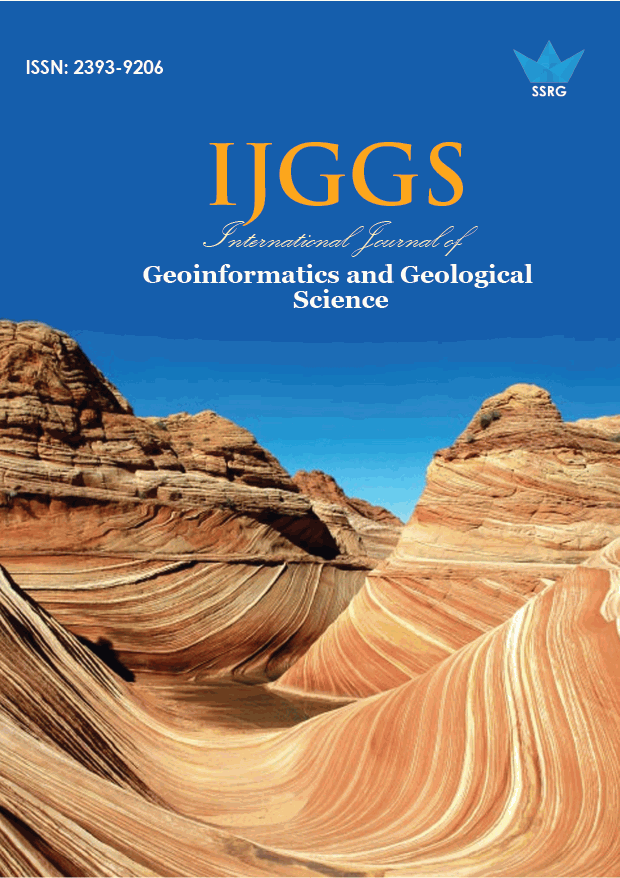The comparison of the Retained Gas in Shale (RGIS) between the Paleocene Ranikot Formation and the lower Cretaceous Sembar Formation, the Southern Indus Basin, Pakistan

| International Journal of Geoinformatics and Geological Science |
| © 2018 by SSRG - IJGGS Journal |
| Volume 5 Issue 3 |
| Year of Publication : 2018 |
| Authors : Nosheen Sahir |
How to Cite?
Nosheen Sahir, "The comparison of the Retained Gas in Shale (RGIS) between the Paleocene Ranikot Formation and the lower Cretaceous Sembar Formation, the Southern Indus Basin, Pakistan," SSRG International Journal of Geoinformatics and Geological Science, vol. 5, no. 3, pp. 33-38, 2018. Crossref, https://doi.org/10.14445/23939206/IJGGS-V5I3P105
Abstract:
In this study, mass balance approach was proposed and applied for volumetric calculations to compute the Retained Gas In Shale (RGIS) of the PaleoceneRanikot Formation and the Lower Cretaceous Sembar Formation in the Southern Indus Basin of Pakistan. The study was conducted based on the data from regional geological sections, base maps, and geochemical data. The volumetric calculations estimated that the Retained Gas In Shale (RGIS) of the Paleocene Ranikot Formation is 115.01 Trillion Cubic feet (Tcf), out of that 13.08 Trillion Cubic feet (Tcf) is risked RGIS while for the Lower Cretaceous Sembar Formation RGIS is 359.41 Trillion Cubic feet (Tcf), out of that 43.13 Trillion Cubic feet (Tcf) is risked RGIS. The results of this study concluded that the Sembar Formation has more shale gas potential in terms of Retained Gas In Shale (RGIS) in the Southern Indus Basin, than the Ranikot Formation. The approach employed in this study for RGIS calculation is pertinent to evaluate source rocks in other sedimentary basins.
Keywords:
Shale Gas, the Ranikot Formation, the Sembar Formation, the Southern Indus Basin, Retained Gas In Shale (RGIS).
References:
[1] Aadil, N., Tayyab, M. H., and Naji, A.M., 2014, Source Rock Evaluation with Interpretation of Wireline Logs; A Case Study of Lower Indus Basin, Pakistan. The Nucleus, 51, 139–145.
[2] Bender, F.K., and Raza, H. A., 1995, Geology of Pakistan. Gebruder Borntraeger, Germany, p. 183–198.
[3] EIA, U., 2013, Annual Energy Outlook 2013. US Energy Information Administration, Washington, DC, p. 60–62.
[4] Jadoon, I. A., Lawrence, R. D., and Lillie, R. J., 1994, Seismic Data, Geometry, Evolution, and Shortening in the Active Sulaiman Fold-and Thrust Belt of Pakistan, Southwest of the Himalayas. American Association of Petroleum Geologists Bulletin, 78, 758–774.
[5] Kemal, A, 1992, Geology and New Trends for Petroleum Exploration in Pakistan. In: Ahmed, G., Kemal, A., Zaman, A. S.H, and Humayon, M. (eds.), New Directions and Strategies for Accelerating Petroleum Exploration and Production in Pakistan. Proceedings of International Petroleum Seminar, November 22–24, p.16–57.
[6] McCarthy, T., and Rubisge, B., 2005, The Story of Earth and Life. Geological Magazine, 145, 334 p.
[7] Peters, K. E., Walters, C. C., and Moldowan, J. M., 2005, The Biomarker Guide–Biomarkers and Isotopes in the Environment and Human History, Vo1. 1. Cambridge University Press, Cambridge, 97, p. 117–118.
[8] Quadri, V.N., and Shuaib, M. 1986, Hydrocarbon Prospects of the Southern Indus Basin, Pakistan. American Association of Petroleum Geologists Bulletin, 70, 730–747.
[9] Schmoker, J. W., 1994, Volumetric Calculation of Hydrocarbons Generated. In: Magoon, L.B., and Dow, W. (eds.), The Petroleum System–from Source to Trap. American Association of Petroleum Geologists Memoir, 60, p. 323–323.
[10] Shah, S. M. I., Ahmad, R., Cheema, M. R., Fatmi, A. N., Iqbal, M. W.A., Raza, H.A., and Raza, S. M., 1977, Stratigraphy of Pakistan. Geological Survey of Pakistan, Memoirs, 12, p.100–137.
[11] Wandrey, C. J., Law, B. E., and Shah, H. A., 2004, Sembar Goru/Ghazij Composite Total Petroleum System, Indus and Sulaiman-Kirthar Geologic Provinces, Pakistan and India. U. S. Geological Survey Bulletin 2208–C, 23 p.
[12] Zaigham, N. A., and Mallick, K. A., 2000, Prospect of Hydrocarbon Associated with Fossil Rift Structures of the Southern Indus Basin, Pakistan. American Association of Petroleum Geologists Bulletin, 84, 1833–1848.

 10.14445/23939206/IJGGS-V5I3P105
10.14445/23939206/IJGGS-V5I3P105